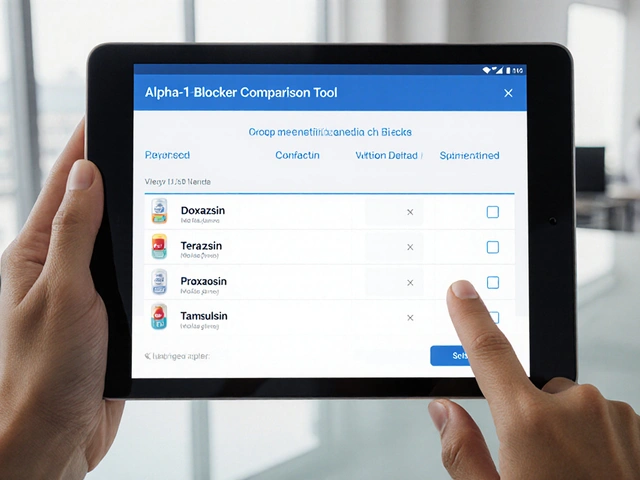Asthma Inhaler Comparison Tool
Find Your Best Rescue Inhaler
Answer a few questions about your needs and we'll recommend the best option from Ventolin, generics, Xopenex, or ProAir RespiClick.
Recommended Inhaler
Cost Comparison
| Inhaler | Without Insurance | With Insurance | Key Benefit |
|---|---|---|---|
| Generic Albuterol | $10-$25 | $10-$20 | Lowest cost, same effectiveness |
| ProAir HFA | $30-$50 | $15-$25 | Softer mist, easier coordination |
| ProAir RespiClick | $50-$70 | $20-$30 | Breath-actuated (no pressing) |
| Xopenex HFA | $70-$100 | $30-$40 | Fewer side effects |
When you’re struggling to breathe, the right inhaler can mean the difference between a normal day and an emergency room visit. Ventolin HFA, the brand name for albuterol, has been the go-to rescue inhaler for millions with asthma and COPD for decades. But it’s not the only option anymore. With rising costs, supply issues, and new generics entering the market, many people are asking: Is there a better alternative to Ventolin? The answer isn’t simple. Some alternatives work faster. Others cost less. A few have fewer side effects. Let’s break down what’s actually out there - and what might work best for you.
What Ventolin Inhaler Actually Does
Ventolin HFA contains albuterol sulfate, a short-acting beta-agonist (SABA). It works by relaxing the muscles around your airways within minutes, helping you breathe easier during an asthma attack or COPD flare-up. The standard dose is two puffs, repeated every 4 to 6 hours as needed. Most people feel relief within 5 to 15 minutes. It’s not a preventive medication - it’s your fast-acting emergency tool.
The HFA version replaced older CFC-based inhalers in the early 2000s due to environmental concerns. Today’s Ventolin delivers the same medicine but with a cleaner propellant. It’s small, portable, and trusted. But here’s the catch: the brand-name version can cost over $60 without insurance in the U.S. That’s why so many people look at alternatives.
Generic Albuterol Inhalers: The Direct Substitute
The simplest alternative to Ventolin is a generic albuterol HFA inhaler. These contain the exact same active ingredient - albuterol sulfate - in the same dose and delivery system. The only differences? The brand name, the color, and the price.
Generic albuterol inhalers are FDA-approved and must meet the same standards as Ventolin. Many pharmacies stock them for under $25 with a coupon or $10-$20 on discount programs like GoodRx. Some common generic brands include:
- ProAir HFA
- Proventil HFA
- AccuNeb (for nebulizer use)
ProAir HFA, for example, uses a slightly different propellant and metering valve. Some users report it delivers a softer mist and feels smoother to inhale. In a 2023 study published in Annals of Allergy, Asthma & Immunology, patients switching from Ventolin to ProAir HFA reported similar symptom control and no increase in side effects.
If you’re looking for the cheapest, most direct swap - go with generic albuterol. It’s not a different drug. It’s Ventolin, just cheaper.
Xopenex HFA: A Gentler Option
Not everyone tolerates albuterol well. Side effects like jitteriness, rapid heartbeat, or hand tremors are common. That’s where Xopenex HFA comes in. It contains levalbuterol, which is the active R-isomer of albuterol. Albuterol is a mix of two mirror-image molecules - only one of them (the R-isomer) actually opens airways. The other (S-isomer) may contribute to side effects.
Xopenex delivers the same benefit - bronchodilation in under 5 minutes - but with about half the dose of active ingredient. Studies show it causes fewer heart-related side effects. A 2022 trial in Respiratory Medicine found patients using Xopenex had 30% fewer palpitations and tremors compared to those on albuterol.
But here’s the trade-off: Xopenex costs about twice as much as generic albuterol. A single inhaler can run $70-$100 without insurance. If you’re young, healthy, and don’t get side effects from Ventolin, Xopenex may be overkill. But if you’re older, have heart conditions, or get shaky hands and a racing pulse after using albuterol - Xopenex is worth asking your doctor about.

ProAir RespiClick: A Different Delivery System
Some people struggle with the timing needed to coordinate pressing an inhaler and breathing in. That’s where ProAir RespiClick stands out. It’s still albuterol - same medicine, same dose - but it’s a breath-actuated device. You don’t press anything. You just inhale hard and fast.
This design reduces the chance of misting the drug into your mouth instead of your lungs. It’s especially helpful for children, elderly users, or anyone with shaky hands. In clinical trials, users of RespiClick had 20% better lung deposition than those using standard HFA inhalers.
The downside? It’s not a direct replacement for Ventolin in terms of cost. RespiClick typically costs $50-$70 with insurance, and even more without. But if you’ve ever missed a dose because you couldn’t time the puff right, this device might save you more than money - it could save your breathing.
Other Alternatives: What Doesn’t Work
Not every inhaler you hear about is a true alternative. Some people ask about Bricanyl (terbutaline) or Primatene Mist. Here’s the truth:
- Bricanyl is not available in the U.S. It’s used in Europe and Canada, but it’s not FDA-approved here.
- Primatene Mist contains epinephrine, not albuterol. It’s available over the counter, but it’s not recommended for regular asthma use. The FDA warns it can raise blood pressure and heart rate dangerously, especially in people with heart disease. It’s only for occasional, mild use - and even then, only if you have no other options.
- Combination inhalers like Advair or Symbicort contain long-acting drugs and steroids. These are for daily control, not rescue. They won’t help during an acute attack.
Stick to FDA-approved rescue inhalers. Don’t experiment with OTC options or foreign brands unless your doctor specifically recommends them.

Cost, Access, and Insurance: What You Need to Know
Price is often the deciding factor. Here’s what you’re likely to pay in late 2025:
| Inhaler | Active Ingredient | Typical Cost (Without Insurance) | Key Advantage | Key Limitation |
|---|---|---|---|---|
| Ventolin HFA | Albuterol sulfate | $60-$80 | Widely recognized, trusted brand | Most expensive brand-name option |
| ProAir HFA | Albuterol sulfate | $30-$50 | Softer mist, easier to coordinate | Still requires hand-breath coordination |
| ProAir RespiClick | Albuterol sulfate | $50-$70 | Breath-actuated, no pressing needed | Higher cost, not all pharmacies stock it |
| Xopenex HFA | Levalbuterol | $70-$100 | Fewer side effects for sensitive users | Double the price of albuterol |
| Generic Albuterol HFA | Albuterol sulfate | $10-$25 | Lowest cost, same effectiveness | May feel harsher on the throat |
With Medicare Part D or private insurance, most of these cost $10-$20 per inhaler. GoodRx and SingleCare coupons can slash the cash price by 50-70%. Always ask your pharmacist: “Do you have a discount program for this?”
Which One Should You Choose?
There’s no single best inhaler. The right one depends on your body, your budget, and your lifestyle.
- Go with generic albuterol if you want the same effect as Ventolin at the lowest cost. It’s the most common switch.
- Try ProAir RespiClick if you struggle to coordinate breathing with pressing the inhaler. It’s a game-changer for kids and older adults.
- Ask about Xopenex if you get shaky hands, a racing heart, or anxiety after using albuterol. The side effects are real - and this version helps.
- Stick with Ventolin only if your doctor specifically recommends it, or if you’ve tried everything else and this one works best for you.
Don’t switch on your own. Talk to your doctor or asthma nurse. They can help you match the inhaler to your needs - and make sure you’re using it correctly. A 2024 study found that nearly 60% of asthma patients use their inhalers wrong, no matter the brand. A quick demo from your pharmacist can double its effectiveness.
What to Do If Your Inhaler Isn’t Working
If you’re using your rescue inhaler more than twice a week (outside of exercise), your asthma isn’t under control. That’s a red flag. Rescue inhalers are for emergencies - not daily use.
If you’re running out of your inhaler faster than usual, or if it doesn’t seem to help as much as before, it’s time to revisit your treatment plan. You might need a daily controller inhaler - like an inhaled steroid - to prevent attacks before they start.
Also, check the expiration date. Inhalers lose potency after a year. Even if it still sprays, it may not deliver the full dose. Replace it on time.
Is generic albuterol as good as Ventolin?
Yes. Generic albuterol inhalers contain the exact same active ingredient, dose, and delivery system as Ventolin. They’re FDA-approved and equally effective. The only differences are the brand name, packaging, and price - with generics costing up to 75% less.
Can I switch from Ventolin to Xopenex without a new prescription?
No. Xopenex is a different medication with a different active ingredient (levalbuterol). Even though it works similarly, it requires a separate prescription. Talk to your doctor if you’re experiencing side effects from albuterol - they can evaluate whether Xopenex is right for you.
Why does my inhaler feel less effective lately?
Inhalers lose potency after 12 months, even if they still spray. Check the expiration date and the number of puffs left - most have a counter. If it’s expired or you’ve used all the puffs, replace it. Also, if you’re using it more than twice a week, your asthma may be worsening and needs a controller medication.
Is ProAir RespiClick better than a standard inhaler?
It’s not better for everyone - but it’s better for people who have trouble coordinating hand pressure with breathing. Since it’s breath-actuated, you don’t need to press a button. This reduces misting in the mouth and improves lung delivery. Studies show it works better for children and older adults.
Can I use Primatene Mist instead of Ventolin?
No. Primatene Mist contains epinephrine, not albuterol. It’s not recommended for regular asthma use and can raise blood pressure and heart rate dangerously. The FDA advises it only for occasional, mild symptoms - and never as a substitute for prescribed rescue inhalers.
If you’ve been using Ventolin for years and it’s working fine, there’s no need to change. But if cost is a burden, side effects are bothering you, or you’re having trouble using it correctly - alternatives exist. The goal isn’t to find the most famous inhaler. It’s to find the one that helps you breathe easiest, safest, and most affordably.









Herbert Scheffknecht
20 Nov 2025 at 01:07Man, it's wild how we treat medicine like it's a luxury brand. Ventolin's just albuterol with a fancy label. We're paying for the logo, not the lung relief. Same chemistry, same mechanism, same goddamn oxygen. The real tragedy isn't the cost-it's that people still believe the hype. Pharma's got us convinced that a different color casing makes it work better. We're not buying sneakers, we're buying time to breathe.
And don't get me started on Xopenex. Levalbuterol's not magic. It's just the R-isomer. The S-isomer? Yeah, it might cause jitters. But so does caffeine. So does anxiety. So does living in this broken system. We're medicating the side effects of capitalism with more expensive medicine. Brilliant.
ProAir RespiClick? Cool tech. But if you can't coordinate a puff, maybe your asthma control needs a rethink, not a new gadget. The device isn't the problem-the system is. We're treating symptoms of a failing healthcare model with $70 inhalers instead of fixing the root.
And don't even mention Primatene. That's the opioid of asthma care. OTC, dangerous, and marketed to people too broke to see a doctor. It's not an alternative-it's a bandage on a hemorrhage.
Generic albuterol? Yeah. That's the real win. Same drug. 75% cheaper. Same chance of survival. The only thing different? The label. And we're still letting corporations profit off our breath.
Stop buying the brand. Start demanding the system change.